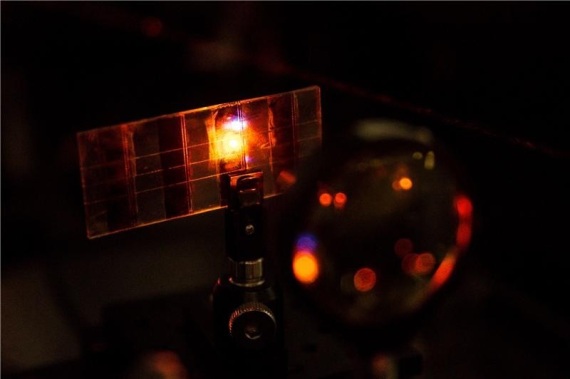Solar by day, light by night
A new, next-generation solar cell material that’s capable of emitting light as well as converting light into electricity has been developed by researchers at Nanyang Technological University in Singapore.
The cells themselves glow when electricity is run through them, and, according to the researchers, the coloring of this emitted light can be easily and cheaply altered.
Given the interesting combination of abilities, this new material – which was developed from Perovskite – seems likely to find a niche for itself. As one possibility, the researchers mention the potential of a shopping mall facade that stores energy during the day and then transforms into a light display for advertisements at night. Interesting idea, especially when you consider that the discovery of this new material’s qualities was actually something of an accident.
The press release from Nanyang Technological University explains:
“What we have discovered is that because it is a high quality material, and very durable under light exposure, it can capture light particles and convert them to electricity, or vice versa,” stated Asst Prof Sum, a Singaporean scientist at NTU’s School of Physical and Mathematical Sciences.
“By tuning the composition of the material, we can make it emit a wide range of colours, which also makes it suitable as a light emitting device, such as flat screen displays.”
NTU’s new Perovskite solar cell as seen in the lab, which was found have light emitting properties

Source: Nanyang Technological University
This property should make for the (relatively) easy commercial adoption of the new material.
Assistant Professor Nripan Mathews from the School of Materials Science and Engineering and the Energy Research Institute, explains: “What we have now is a solar cell material that can be made semi-translucent. It can be used as tinted glass to replace current windows, yet it is able to generate electricity from sunlight. The fact that it can also emit light makes it useful as light decorations or displays for the facades of shopping malls and offices.”
“Such a versatile yet low-cost material would be a boon for green buildings. Since we are already working on the scaling up of these materials for large-scale solar cells, it is pretty straightforward to modify the procedures to fabricate light emitting devices as well. More significantly, the ability of this material to lase, has implications for on-chip electronic devices that source, detect and control light.”
This NTU breakthrough has already won praise from external experts. Professor Ramamoorthy Ramesh, the Purnendu Chatterjee Endowed Chair in Energy Technologies professor at the University of California, Berkeley in the United States said: “This work from the NTU SinBeRISE team clearly shows the promise of such new materials in a broad range of applications, including solar cells and now for lasing. It also shows the power of interdisciplinary, basic science in making fundamental discoveries that will impact in a broad sense.”
Something important to note about all of this is the fact that the new material is very affordable – roughly “five times cheaper than current Silicon-based solar cells,” the press release notes. “This is due to its easy solution-based manufacturing process, which works by combining two or more chemicals at room temperature.”
The ease of production and relative cheapness certainly bodes well for the material. It’ll be interesting to see the ways that this material is utilized over the coming years.
The new findings were detailed in a paper published in the journal Nature Materials.
Originally published on CleanTechnica. Reproduced with permission.
















